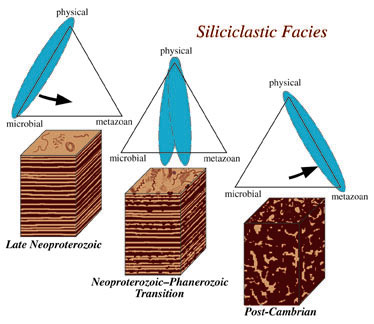

Figure 2. Change in processes controlling character of seafloor sediments during the Neoproterozoic-Phanerozoic transition, for siliciclastic neritic (below normal wave base to shelf edge) environments. These processes, indicated on the triangular diagrams, are physical (causing primary deposition of sediments), microbial (also producing primary structures), and subsequent bioturbation by metazoans. Changes in triangular diagram blue fields show change in relative dominance of these processes through this transition. Schematic seafloor cores indicate characteristic physical and biogenic sedimentary structures during this transition, from laminated and thin bedded (left), to partially bioturbated (center), to completely bioturbated (right). Derived from data in Droser (1987), Hagadorn and Bottjer (1997, 1999), Droser et al. (1999), and McIlroy and Logan (1999).